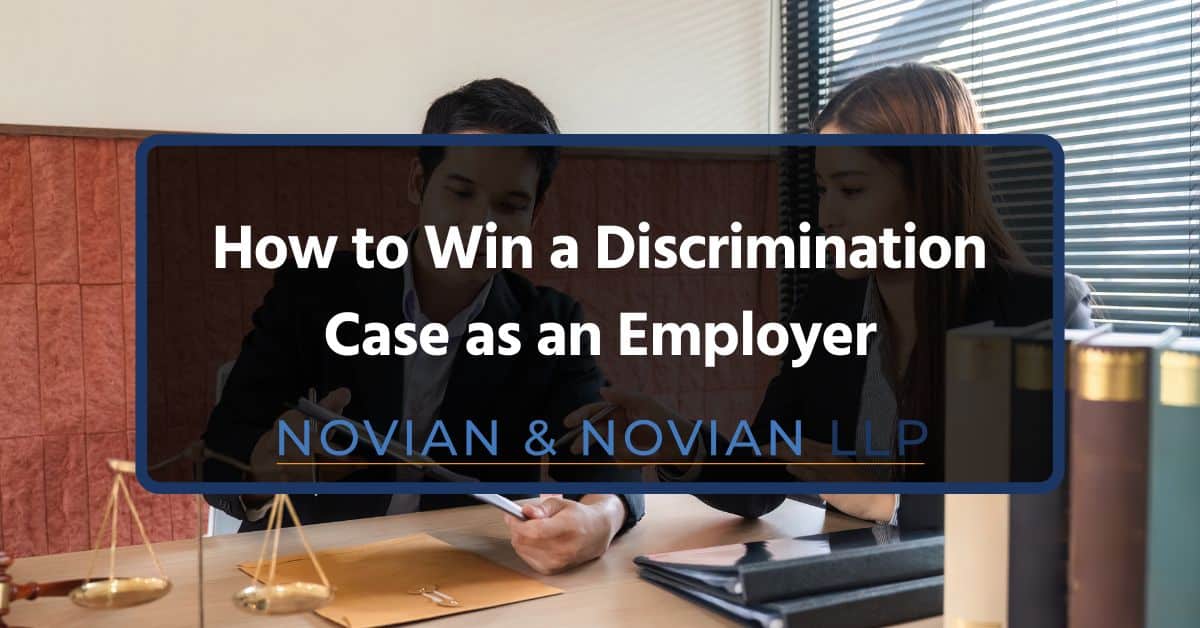Winning a discrimination lawsuit as an employer requires preparation, documentation, and legal expertise. To position your company for success against a discrimination lawsuit, it is important to document everything. You also need to conduct prompt and thorough internal investigations and work with legal counsel as soon as possible.
Discrimination cases are usually complex, and the best way to protect your company is by working with skilled employment attorneys who know how to build a strong defense and avoid costly missteps. At Novian & Novian, we have experienced attorneys in all aspects of employment law in California. Contact us today for a consultation!
This blog will cover a step-by-step breakdown of how to protect your company. It will also talk about how to deal with state agencies and how to prevent discrimination claims.
What Constitutes Workplace Discrimination?

Workplace discrimination occurs when an employee or job applicant is treated unfairly or unequally based on a protected characteristic. Protected classes include race, color, national origin, gender, sexual orientation, religion, age, disability, and other personal attributes. Discriminatory practices may be overt or subtle, but if an employer’s conduct negatively affects someone’s employment status or work conditions because of a protected class, it may be considered discrimination under federal and state law.
At the federal level, several important laws govern employment discrimination. Title VII of the Civil Rights Act prohibits discrimination based on race, color, religion, sex, or national origin, while The Americans with Disabilities Act (ADA) protects individuals with disabilities and requires employers to provide reasonable accommodations when necessary.
Similarly, The Age Discrimination in Employment Act (ADEA) makes it unlawful to discriminate against workers aged 40 and older. In addition, the Family and Medical Leave Act (FMLA) provides specific protections for employees who need time off for family or medical reasons. These laws are enforced by the Equal Employment Opportunity Commission (EEOC), which investigates formal complaints and ensures compliance.
California, for example, offers broader protections under state-specific statutes such as the California Fair Employment and Housing Act (FEHA). This law includes additional protected characteristics such as gender identity and expression, marital status, and medical condition. Employers in California should be particularly aware of these extended requirements, as California discrimination lawsuits tend to result in significant court costs and damages, including compensatory damages for emotional distress and punitive damages in severe cases.
Employers have a legal and ethical responsibility to prevent discriminatory actions in the workplace. This includes establishing zero tolerance policies, training managers, responding promptly to complaints, and ensuring fair treatment in every job application, promotion, or termination decision. Failure to accommodate disabilities or religious practices, harassment by co-workers or supervisors, and discriminatory terminations or demotions are all common triggers for workplace discrimination claims. These actions can lead to administrative charges, lengthy litigation, and the possibility of a costly discrimination lawsuit.
Common Triggers for Workplace Discrimination Claims
Many discrimination cases begin with specific workplace events or decisions that employees perceive as unfair or unjustified. One of the most frequent triggers for a workplace discrimination lawsuit is termination or demotion.
When an employee in a protected class is fired, laid off, or denied a promotion without clear documentation or legitimate cause, it can quickly escalate into a formal complaint. Employers must be able to prove that their decision was based on performance, conduct, or business necessity, and not on discriminatory motives related to race, age, gender, disability, religion, or national origin.
Harassment by co-workers, supervisors, or management is another major cause of employment discrimination claims. This includes both verbal and physical conduct that creates a hostile work environment based on a protected characteristic. Even if an employer is not directly involved, failure to act on reported incidents can result in liability. Employers should enforce zero tolerance policies and train all employees on acceptable workplace conduct.
Failure to accommodate disabilities or religious practices often leads to disability discrimination claims under the ADA or religious discrimination under Title VII. An employer’s refusal to provide reasonable adjustments or scheduling flexibility can be seen as discriminatory action and may entitle the employee to sue for compensatory damages, back pay, front pay, and even emotional distress.
Disgruntled employees may also allege retaliation if they believe they were punished for asserting their rights or supporting another employee’s complaint. These allegations are taken seriously by the Equal Employment Opportunity Commission (EEOC) and can result in a lengthy and expensive discrimination case if the employer cannot provide evidence supporting their decisions.
How to Win a Workplace Discrimination Lawsuit as an Employer
A workplace discrimination lawsuit can be filed through the Equal Employment Opportunity Commission (EEOC) or a state-level agency. Often, an administrative charge is followed by a sue letter allowing the plaintiff to take the matter to court.
If a claim reaches this stage, the employer must provide compelling evidence and a legitimate, non-discriminatory reason for every employment decision challenged in the lawsuit. Working with employment lawyers and building a strategy early on, especially from the moment an employee threatens to sue, can significantly improve the outcome.
Here’s a detailed guide on what to do when an employee starts a lawsuit:
Build a Strong, Documented Defense from Day One

One of the most effective ways to win a discrimination case is to build a solid defense from the moment an issue arises in the workplace. Employers should keep clear and consistent documentation of all employee behavior, performance reviews, job applications, complaints, and disciplinary actions.
A detailed record that shows objective evaluations and patterns of fair treatment across all employees and not just the plaintiff can be used to prove the absence of discriminatory action. The court will scrutinize whether the company enforced zero tolerance policies uniformly and whether there were any deviations based on a protected characteristic.
In discrimination in the workplace cases, inconsistencies can be fatal. If an employer is unable to provide documentation, it becomes easier for a plaintiff to claim they were a victim of discriminatory practices. Even if the end date of employment was due to legitimate reasons like restructuring or financial constraints, lack of records can create doubt and emotional distress damages may follow.
Show Legitimate, Non-Discriminatory Reasons for Employment Decisions
To dispute claims of discrimination, employers must demonstrate that decisions such as termination, demotion, or failure to promote were based on business necessity, not bias. This includes showing objective performance metrics and examples of similar actions taken against co-workers outside the protected class.
For example, if an employee claims age discrimination, the employer can point to younger employees who were treated similarly under the same policies. This counters the narrative of discriminatory intent and supports a motion for summary judgment.
Evidence should be factual, specific, and supported by records, not hearsay or assumptions. Employers must prove that they were acting in the best interest of the company and not motivated by a protected class such as race, religion, national origin, or disability. Providing evidence like written warnings, poor evaluations, and unmet performance goals can make it easier to defend against allegations and reduce exposure to compensatory damages and court costs.
Ensure Fair and Thorough Investigation of Complaints

Another critical step in defending a workplace discrimination lawsuit is ensuring that all internal complaints are investigated thoroughly and fairly. Employers should always follow established protocols when a complaint is filed. Assigning an impartial party to handle the investigation and taking detailed statements from the employee and co-workers helps show that the process was fair and unbiased.
This is especially important in retaliation claims, where the plaintiff may argue they were punished for filing a complaint. A well-documented internal response process that treats every complaint seriously, regardless of the outcome, can help avoid claims of emotional harm or failure to act. Following your own protocols shows that your company values justice, fairness, and compliance with employment laws such as Title VII, the ADA, and the ADEA.
Counter the Plaintiff’s Claims with Solid Evidence
When the lawsuit proceeds, your ability to counter the plaintiff’s claims will often depend on whether you can provide evidence that contradicts the allegations. Highlight inconsistencies in the employee’s story or conduct. Bring in co-workers or supervisors who can testify that the employee was treated fairly and that the employer’s decisions were consistent with its employment policies.
In many cases, the plaintiff may allege discrimination based on a perceived pattern. If you can show that similarly situated employees, regardless of their age, disability, sexual orientation, or race, received the same treatment under comparable circumstances, it may undermine their case. The ability to disprove intent or bias through concrete examples can reduce or eliminate potential compensation for emotional distress, lost benefits, and other damages.
Seek Expert Legal Guidance From an Employment Lawyer
Legal representation is not optional in these high-stakes cases. An experienced discrimination lawyer can help identify legal defenses, respond to the complaint, and negotiate a potential settlement before the case proceeds to trial. They can also advise you on whether to pursue summary judgment or settle out of court, depending on the strength of your evidence and the risks involved.
The cost of hiring an employment lawyer varies depending on factors like case complexity, location, and the lawyer’s experience. Some attorneys charge hourly rates, while others work on contingency or offer flat fees for specific services.
If an employment attorney charges on an hourly basis, it can range from $300 to $1,500 per hour. However, if they work on a contingency basis, it could range between 30%-40%.
How to Deal With an EEOC or State Agency Complaint

As an employer, you should take time to understand how the EEOC or the state fair employment agency handles these complaints. The process often begins with a notice of charge and request for information, followed by an investigation that can involve document reviews, interviews, and site visits.
Your response must be detailed and prompt, supported with relevant documentation, including employment records, policies, and any communications related to the complaint. Demonstrating a history of consistent enforcement of company rules and zero tolerance policies for discrimination can be a powerful way to counter claims of a hostile work environment or unfair treatment based on a protected characteristic.
Cooperation with the agency is also key. Providing full and honest information builds credibility and can influence how the investigator views your case. It’s important not to withhold or alter information, as doing so can raise suspicions of discriminatory practices or retaliation, potentially escalating the matter to litigation. Employers should work closely with their employment lawyers during this phase to ensure they are complying with all legal requirements while also protecting the company’s best interests.
In many cases, the EEOC or state agency may offer mediation as a way to resolve the complaint before it progresses further. Employers should approach mediation seriously, as it can be an effective way to settle disputes early, reduce court costs, and avoid prolonged reputational damage. A well-prepared employer with compelling evidence and a willingness to listen may find that mediation leads to a fair resolution without the need for a formal lawsuit.
What Employers Should Do to Prevent Discrimination Claims

Every employer should develop and enforce a comprehensive anti-discrimination policy that explicitly prohibits discriminatory practices based on race, religion, age, disability, national origin, sexual orientation, or any other protected characteristic. This written policy must clearly explain what constitutes discrimination and should outline the steps for making a formal complaint, as well as how such complaints will be addressed within the organization. A well-documented and consistently enforced policy creates a foundation for zero tolerance and sets expectations across the company.
In addition to having a clear policy, regular training is critical for preventing employment discrimination. Employers should provide frequent training sessions for all employees, especially managers, on how to recognize discriminatory action, avoid retaliation, and ensure equal employment opportunities. Training should also cover how to interact respectfully with co-workers and how to file a complaint if an employee feels discriminated against. The training must align with current laws and guidance from the Equal Employment Opportunity Commission (EEOC), including California-specific requirements for harassment prevention in the workplace.
Employers must foster an environment where employees feel safe and empowered to report workplace discrimination without fear of retaliation. Employees should clearly understand how to file a complaint and be confident that their claims will be investigated fairly and without bias. Transparent reporting systems, such as confidential hotlines or designated HR contacts, are essential to uncovering potentially discriminatory conduct before it escalates to a legal claim or administrative charge. When an employee believes they are a victim of discriminatory practices, the employer’s ability to show that there were processes in place to address those concerns in good faith can be a critical defense in court.
Consistency is also a key principle in protecting against a discrimination lawsuit. Employers must ensure that anti-discrimination and disciplinary policies are enforced fairly and uniformly, regardless of who the employee is. Favoritism or selective enforcement, even if unintentional, can quickly become grounds for a discrimination case and may be viewed as compelling evidence by a judge or jury.
Need Skilled Legal Help to Protect Your Business?
Discrimination claims often results in substantial costs, emotional harm, and even punitive damages if not properly handled. However, these claims are often avoidable when employers build a strong foundation of compliance, fair policies, and expert legal guidance.
The formula for success is simply a proactive culture that prioritizes zero tolerance for discriminatory practices, detailed documentation of employment decisions, and the support of knowledgeable employment lawyers. Whether you’re responding to a formal complaint filed with the Equal Employment Opportunity Commission (EEOC), dealing with retaliation claims, or deciding whether to settle or litigate, having a skilled legal team on your side can make all the difference.
At Novian & Novian, we’ve built a reputation as one of the best employment attorneys in California, with over 35 years of experience defending employers in even the most complex discrimination lawsuits. Schedule a free consultation with us now!
FAQs
Why Are Discrimination Claims Difficult to Prove?
Discrimination claims often rely on circumstantial evidence and require the plaintiff to prove discriminatory intent, which can be difficult without clear, direct proof. Employers can defend themselves by showing legitimate, non-discriminatory reasons for their actions.
How Long Do I Have to Respond to an EEOC or State Agency Complaint?
Typically, employers have 30 days to respond to a complaint from the EEOC or state agency. However, the exact deadline may vary depending on the jurisdiction.
Can an Employer Be Penalized for Retaliating Against an Employee Who Files a Discrimination Complaint?
Yes, retaliation is illegal under federal and state laws, and employers can face additional penalties and damages if they take adverse action against an employee for filing a complaint.
How Do I Make Sure My Business Complies With Discrimination Laws?
Maintain a clear anti-discrimination policy, train staff regularly, enforce policies consistently, and consult with employment lawyers to ensure compliance with state and federal laws.

